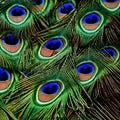My very first Substack essay, for those who missed it the first time...What have peacock tail feathers ever done for the peacock? They are heavy, they harbor parasites, and they add nothing to the bird's ability to eat, drink, or move. So why have they persisted generation after generation?
A peacock's tail is an example of an elaborate display of reproductive fitness. A bird that has so much energy to waste on mere display must have plenty going on as a potential mate, is the apparent basis for the tail's attraction.
While the male of the bird species is the one with the big feathers, in humans it is the female who carries the burden of decorative display. Any woman who has wedged her feet into high heels or stayed up late swabbing the evening's makeup off her face knows all about appearance and courtship rituals. In fact, studies have shown that males pay much more attention to the appearance of females than women do to men. And the main thing males look for in courtship is signs of fertility, which are tied to youth. No wonder there are multibillion dollar industries that depend on the female demand to conform to youthful standards of appearance: the makeup industry, the diet industry, the cosmetic surgery industry. All these industries are ultimately powered by the impulses of evolutionary biology.
We know that human women, unlike other species, live way past our reproductive years. In evolutionary terms, it makes sense that human males would avoid mating with late-life women (or it did in the past; the population explosion is not a big concern for evolution). But in human terms, from the sexy midlife women's point of view, it can make sense to display signs of reproductive fitness long after those signs no longer apply. As a woman who went grey at forty, and still tints her hair in her seventies, I am amazed at how that one little signal of long blond hair changes how people react.
Blond hair on a woman is a lot like a big tail on a peacock: it is a conspicuous display, that may be completely inaccurate, but still conveys advantages. When I read articles about what older women should not wear, or whether we should dye our hair, I wonder whether the writers of those articles understand the ancient game we are playing. We don’t just fool each other when we stage these displays. We fool our DNA.
I’m jazzed to be on the final edits for my essay collection, Rock On: Power, Sex & Money after Sixty. More to come soon about cover and launch date. In the meantime, here’s what author Joan Price (Naked at Our Age) says about the upcoming book.





